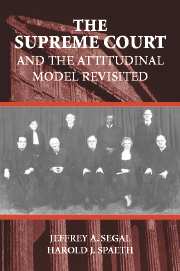Book contents
- Frontmatter
- Contents
- List of Illustrations
- List of Tables
- Preface
- 1 Introduction: Supreme Court Policy Making
- 2 Models of Decision Making: The Legal Model
- 3 Models of Decision Making: The Attitudinal and Rational Choice Models
- 4 A Political History of the Supreme Court
- 5 Staffing the Court
- 6 Getting into Court
- 7 The Decision on the Merits: The Legal Model
- 8 The Decision on the Merits: The Attitudinal and Rational Choice Models
- 9 Opinion Assignment and Opinion Coalitions
- 10 The Supreme Court and Constitutional Democracy
- 11 Conclusion
- Case Index
- General Index
3 - Models of Decision Making: The Attitudinal and Rational Choice Models
Published online by Cambridge University Press: 05 June 2012
- Frontmatter
- Contents
- List of Illustrations
- List of Tables
- Preface
- 1 Introduction: Supreme Court Policy Making
- 2 Models of Decision Making: The Legal Model
- 3 Models of Decision Making: The Attitudinal and Rational Choice Models
- 4 A Political History of the Supreme Court
- 5 Staffing the Court
- 6 Getting into Court
- 7 The Decision on the Merits: The Legal Model
- 8 The Decision on the Merits: The Attitudinal and Rational Choice Models
- 9 Opinion Assignment and Opinion Coalitions
- 10 The Supreme Court and Constitutional Democracy
- 11 Conclusion
- Case Index
- General Index
Summary
The legal model, as Chapter 2 explains, holds that the Supreme Court decides disputes before it in light of the facts of the case vis-à-vis precedent, the plain meaning of the Constitution and statutes, and the intent of the framers. We have shown that both litigants generally have precedents supporting them and each side typically alleges that either the plain meaning of the legal provisions at issue and/or the intent of the law makers supports its position. If various aspects of the legal model can support either side of any given dispute that comes before the Court, and the quality of these positions cannot be reliably and validly measured a priori, then the legal model hardly satisfies as an explanation of Supreme Court decisions. By being able to “explain” everything, in the end it explains nothing.
THE ATTITUDINAL MODEL
We move now to an alternative explanation of the Court's decisions, the attitudinal model. The attitudinal model represents a melding together of key concepts from legal realism, political science, psychology, and economics. This model holds that the Supreme Court decides disputes in light of the facts of the case vis-à-vis the ideological attitudes and values of the justices. Simply put, Rehnquist votes the way he does because he is extremely conservative; Marshall voted the way he did because he was extremely liberal.
The Legal Realists
The attitudinal model has its genesis in the legal realist movement of the 1920s. The movement, led by Karl Llewellyn and Jerome Frank, among others, reacted to the conservative and formalistic jurisprudence then in vogue.
- Type
- Chapter
- Information
- The Supreme Court and the Attitudinal Model Revisited , pp. 86 - 114Publisher: Cambridge University PressPrint publication year: 2002
- 1
- Cited by



